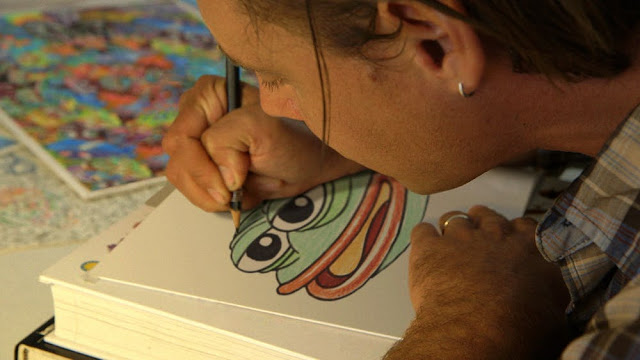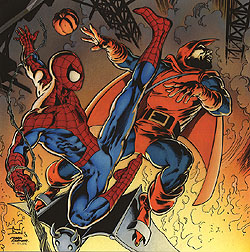Horror has been my favorite genre for a long time, as you surely know if you've ever read this blog. It is the most consistent when it comes to offering a look at the deep-rooted fears and traumas of the place where it's made. It's not an exaggeration to say that if you become familiar with the horror films of a certain country, you will have a better insight into that country. Not necessarily the same as visiting, but since international travel is a pipe dream these days, you gotta take what you can get.
There is so much to offer and yet a lot of viewers are missing out. As much as I love the horror community on Twitter (one of the major reasons I have an account there at all), I've learned that there is a contingent of the fandom that are total meatheads when it comes to anything subtitled. For example, whenever the popular streaming show The Last Drive In with Joe Bob Briggs picks an Asian or European horror film to screen, there's always the chorus of people whining about the subtitles. Yes, in 2021. I don't get it. If you can find an English dub, great. But don't let something so minor rob you of these experiences because I can guarantee you'll find a lot of the same thrills that make English-language horror appealing.
This October, I decided to take a quick trip around the world and pick a horror movie from a different country every day. Most of these are great films that reflect well on their countries of origin. However, the pickings were slim in a few places and I had to choose based on what I've been able to see. That's one thing remarkable about being a movie buff - the more you see and learn, the more you realize you still have to see and learn. You're never "done" and that's how I like it.
Feel free to read this all in one sitting or one entry per day to correspond with the month of October. Whatever you think would be most fun. Either way, we're starting close to home.
1. United States - Night of the Living Dead (1968)
It's difficult to find good things to say about the USA in this day and age, but we do have a proud history of horror films. This film in particular was such a shock that the whole of horror's history as a genre can be divided into two halves - before Night of the Living Dead and after it. In addition to establishing most of the rules of the zombie subgenre (which had previously focused more on the Haitian/voodoo approach), George Romero's grainy black and white nightmare was a genuine bombshell to audiences used to science-fiction creature features that always ended happily with the defeat of the man in the rubber monster suit.
The hero was a young black drifter named Ben, played by Duane Jones in a bit of casting that was brave for 1968. Meanwhile, the ostensible heroine was driven insane by the events of the first ten minutes. Most of the story took place in a cramped farmhouse that was slowly overrun by the zombies breaking through the doors and windows. A child zombie killed her own parents. The violence became tame even by the end of the 1970s but the brutal ending will never lose its power to shock. The trauma of so many years of racial violence and Vietnam gave birth to this movie and a golden age of American horror that lasted throughout the next decade.
2. United Kingdom - The Wicker Man (1973)
Anyone who knows the name only because of Nicolas Cage's ridiculous yelling in the Neil Labute remake is missing out. The original film, directed by Robin Hardy, is a stone cold classic and often posited as the greatest British horror movie ever made. The pious detective Neil Howie travels to a remote island in search of a missing girl and discovers a seemingly harmless pagan commune led by Lord Summerisle (the late great Christopher Lee). It greatly offends his Christian sensibilities and he doesn't hesitate to make that known. By the time we get to the legendary twist ending, Howie has much more to worry about than blasphemy.
The conflict between Christianity and the ancient pagan religions is especially resonant when coming from the UK. Whether it's Celtic myth or the Norse beliefs of invading Vikings, the country has a long history of fascinating regional beliefs being suppressed by the advent of Christian churches from mainland Europe. It's probably the reason why the many, many ripoffs (most recently Midsommar) can't quite replicate its magic.
3. Germany - The Cabinet of Dr. Caligari (1920)
This masterpiece is the most famous example of the German expressionist style and is often considered the first true horror film. A man at an insane asylum tells the story of the evil Dr. Caligari, who orchestrated a string of murders committed by his sleepwalking minion Cesare. The thin story is overshadowed by the stunning production design, full of jagged architecture and distorted perspectives that was downright radical at such an early point in cinematic history. It was made shortly after World War I and is the product of a deeply traumatized nation, furious at authority and doubting if they would ever recover. Anyone interested in how the Great War shaped the early days of horror cinema should definitely check out Scott Poole's excellent book Wasteland.
Although the twist ending was reportedly forced upon the writers, it continues to inspire filmmakers over a century later. Like many of its progeny, it doesn’t really make a lot of sense if you think about it.
This movie scared the absolute shit out of me the first time I saw it. One of the best films that came out of the internationally renowned "J-horror" wave of the late 90s and early 00s, Ju-On begins with a brief depiction of a heinous crime shot like a grainy home movie. That bit itself is quite disturbing, but you're just getting started. The house where the murders occurred becomes a deathtrap as anyone who enters it is stalked by a ghost with nearly limitless power.
12. India - Phoonk (2008)
In the United States, the cinema of India might as well be another universe. Many associate the country with colorful musicals but haven't seen any. Indian horror films are even tougher to find. Nobody seems in any hurry to get them seen in this part of the world - sometimes you can find one streaming somewhere only to find that there are no English subtitles. The difficulty is unfortunate because I would like to get more insight on what frightens this deeply conservative, traditionalist nation.
The prolific director Ram Gopal Varma is something of a trendsetter in Indian horror, and he offered viewers a large cash reward if they could watch this film alone in a theater, which must have been hard to manage given its box office success. It was a bold move for a movie with a title that sounds like a cork being pulled from a bottle. The atheist entrepreneur Rajiv has a bitter falling out with two of his close associates, who place a curse on his daughter that invites an evil spirit. As with The Exorcist, the unbeliever is forced to seek spiritual help after medical science proves useless. With little in the way of blood or special effects, the movie relies on its emphatic score and some interesting camerawork to scare viewers. Still, it’s hard to imagine this drawn-out film frightening anyone who didn’t already put a lot of stock in cultural superstitions. One passing moment I found interesting - a female character is meant to be seen as a threat by the audience because she refuses to lower her eyes while arguing with Rajiv.
16. New Zealand - Braindead (1992)
Despite my dedication to this genre, I have yet to see a serious New Zealand horror film. I assume there are some out there, but in general horror-comedies dominate here. Movies like Black Sheep, What We Do In The Shadows, Deathgasm and Killer Sofa are the norm, which suggests a country not especially willing to show vulnerability. I would be curious to see what that might look like, perhaps drawing on the struggles of the indigenous Maori people, but it's hard to complain when they're just so good at what they do now.
Also known as Dead Alive, this early Peter Jackson classic is the bloodiest movie ever made if one is making the judgement simply based on the amount of blood spilled on screen. However, it’s much more likely to make you laugh than scare you. Lionel lives under the thumb of his psychotic, domineering mother but is considering breaking away when he falls for Paquita. Unfortunately, Mum gets bitten by a “Sumatran rat-monkey” and becomes a decaying zombie spreading her condition to other people. Plenty of gross-out humor ensues (one scene involving custard is almost vomit-inducing) until the absolutely brilliant final act, a jaw-dropping showcase of practical gore effects full of creativity that only the most uptight scold wouldn’t appreciate. I watched this one a lot as a teenager and can attest that it's a massive hit at parties.
Anyone who has read this blog within the past year or so will recognize this one, which I believe will be one of the great films of the decade, never mind that the decade is young. It's a ghost story within the larger real-life tale of former president Efrain Rios Montt, who was responsible for a genocidal campaign that killed over 100,000 of Guatemala's indigenous Mayan people in the 1980s. The dictator in this film is named Enrique Monteverde, but anyone who saw this movie in Guatemala knew damn well what it was really about.
18. Indonesia - The Queen of Black Magic (2020)
In the 1980s, Indonesia had a run of bonkers low-budget horror like Mystics in Bali and Lady Terminator but faded from international view for a long time afterwards. During the last decade, the streaming boom helped bring attention to a new generation of talent that has made some fearsome movies. One of the biggest names in this revival is Joko Anwar, who wrote the screenplay for this intense film directed by Kimo Stamboel. The story begins when three men bring their wives and children to the rural orphanage where they grew up. While visiting the ailing owner of the place, they realize the building is haunted because of an unspeakable crime that occurred when they were kids. The bus on the nearby road full of dead bodies is also probably a bad sign. It can be hard to keep all the characters straight but this is still one hell of a horror movie with a ruthless final act. Anyone who is creeped out by insects is going to have a particularly bad time. In a nice bit of Asian horror camaraderie, one of the major scares is clearly a tribute to Ringu.
The premise of people returning to the boonies to discover a terrible secret is pretty common with these films and it's hard not to speculate about a connection to the 1960s genocide overseen by the Suharto regime and thrust back into the spotlight in 2013 by the documentary The Act of Killing. This film in particular seems driven by something darker than just a straightforward supernatural story and the ultimate reveal of how one generation has failed another makes a lot of sense in that context.
This film can feel a bit primitive in terms of its narrative, but the black and white photography is often striking. A few years later, a sequel was released called This Night I'll Possess Your Corpse and in 2008 Marins returned to play the villain as a senior citizen in Embodiment of Evil.
20. Thailand - Shutter (2004)
The J-horror wave lifted up a few Thai films as well, including this involving ghost story loaded with clever scares. Tun is a fashion photographer driving home with his girlfriend when they hit a young woman and leave the scene. After a few spooky encounters and creepy images in Tun's pictures, they begin to suspect they are being haunted by the ill-fated pedestrian...who was definitely not a stranger. The mystery unfolds very nicely up until the final reveal, a potent visual representation of guilt. It also became an unintentional tribute to traditional photography, with crucial scenes involving darkrooms and Polaroid cameras just as everything was about to go digital.
21. Iran - Under the Shadow (2016)
Most movies made during the 2010s that take place in the 1980s are full of nostalgia. This one...not so much. This is a slow-burning movie about a frustrated woman named Shideh, who has been banned from medical school by the state because of her participation in leftist groups before the 1979 revolution turned Iran into a theocracy. During the brutal decade-long war with Iraq, her husband is drafted and she is left behind in the family apartment with her young daughter. Over time, she realizes they are being menaced by a malevolent djinn, an obvious but still potent metaphor for the anxiety that comes with war, social upheaval and oppression. The moment where a missile hits the apartment building is as frightening as anything the djinn does. It's sad that the Western world is only interested in Iran when it comes to things like nuclear weapons and religious extremism because underneath that is an ancient culture with a lot to offer.
22. Argentina - Aparecidos (2007)
This is not a widely known film, which is a shame because it's very powerful. Two siblings named Malena and Pablo return from Spain to their native Argentina as their father is comatose on his deathbed. Pablo gets the idea to drive to the rugged southern region of the country to find the family’s old home, which leads to a series of encounters with apparitions who appear to be re-enacting a murder from twenty years earlier. Against their better judgment, the siblings get involved and several heartbreaking revelations are revealed.
The title is a reference to the “desaparecidos,” the people who were abducted and murdered by a right-wing dictatorship during Argentina’s “dirty war.” As this history gets more central to the plot, the movie becomes moving and much more frightening than it might have been as a typical ghost story. Without this added gravitas, it would be harder to forgive the script’s reliance on poor decision making - without Pablo’s constant impulsive behavior, there would be no movie.
23. Austria - Cold Hell (2018)
Another mainstay as far as this blog is concerned, but what can I say? It's just really good. In the cultured streets of Vienna, a serial killer is targeting Muslim women. One crime is witnessed by Ozge, a Turkish cab driver who becomes his next target. Unfortunately for the killer, she is an aspiring kickboxer with a lot of unresolved anger. In addition to some first-class suspense and action, Violetta Schurawlow's performance as the surly heroine is a large part of the reason the movie really works. She is just a grump but you root for her anyway.
It can be tough to pin down exactly what this movie is saying about the experience of Middle Eastern immigrants in Europe. Most viewers will expect the reveal of the killer's identity to go a certain way and be surprised at what actually happens. Lots of possible interpretations, but I think of it as a reminder that the only thing that really distinguishes brutality in the third world versus the first world is a nice suit and a sleek office.
24. Cuba - Juan of the Dead (2012)
How many horror stories out there have titles that are just variations on Dawn of the Dead? Someone should look into that. Juan is a fisherman prone to harebrained schemes who encounters a zombie in the ocean one day. Before long, they are swarming Havana and the enterprising Juan starts his own business devoted to killing them so their family members don't have to. He literally picks up the phone and says "Juan of the Dead, we kill your loved ones." There's some cheeky satire about Cuba's useless communist government - they claim the zombies are actually "dissidents" planted by the United States - but capitalism doesn't come out looking all that great either. There's a lot to like here, although the emotional element isn't as strong as, say, Shaun of the Dead. The tension between Juan and his embarrassed daughter feels like it's been done in a thousand other movies.
29. Romania - Be My Cat: A Film For Anne (2016)
Ever since the clever marketing campaign for The Blair Witch Project, it has been assumed that no found footage movie would ever fool the public the same way again. This disturbing and highly believable tale of obsession and madness easily comes the closest. Adrian (played by the director) is an aspiring filmmaker who became fixated on actress Anne Hathaway after seeing her performance as Catwoman in The Dark Knight Rises. The film we’re watching is his plea for Hathaway to come to Romania and star in his movie, with Adrian frequently talking to the camera as if she was right there. Once he begins to work with local actresses, it becomes clear that Adrian is not just delusional but totally no holds barred crazy, justifying his vicious treatment of them with the pompous authoritarian rhetoric about “art” sometimes used by a certain type of male director.
It’s frighteningly convincing and the kind of experience that gets audiences debating on whether a movie can be “too real.” I'm very curious about whether Anne Hathaway has actually seen it. If she has, she hasn't said anything.
30. Pakistan - Hell's Ground (2007)31. Kenya - In the Shadow of Kilimanjaro (1986)
We're at the end now and every continent has been covered (until some killer penguin movie comes out of Antarctica). This animal attack movie was based loosely on a true incident in 1984 when a brutal drought led to a few incidents where starving baboons attacked the residents of a nearby small town. The movie blows this up into a whole horde of baboons laying siege to the place. The half-baked story and characters will have viewers glancing at the time waiting for the monkeys to show up but it's worth waiting. The animal work is really quite impressive. Monkeys seem cuddly until they're ganging up to try and kill you.























































